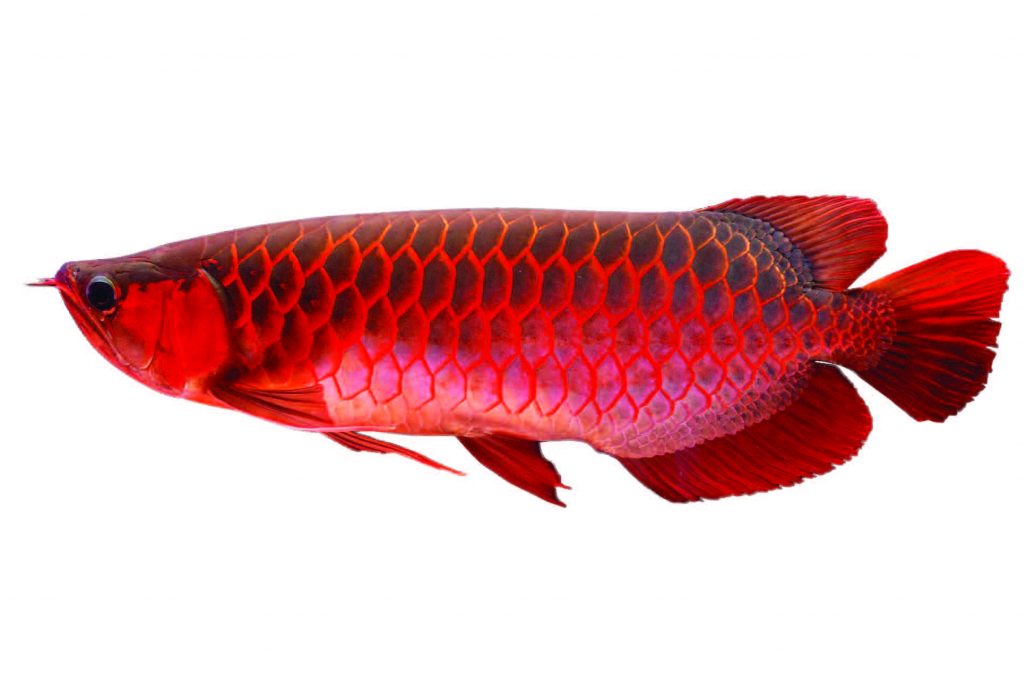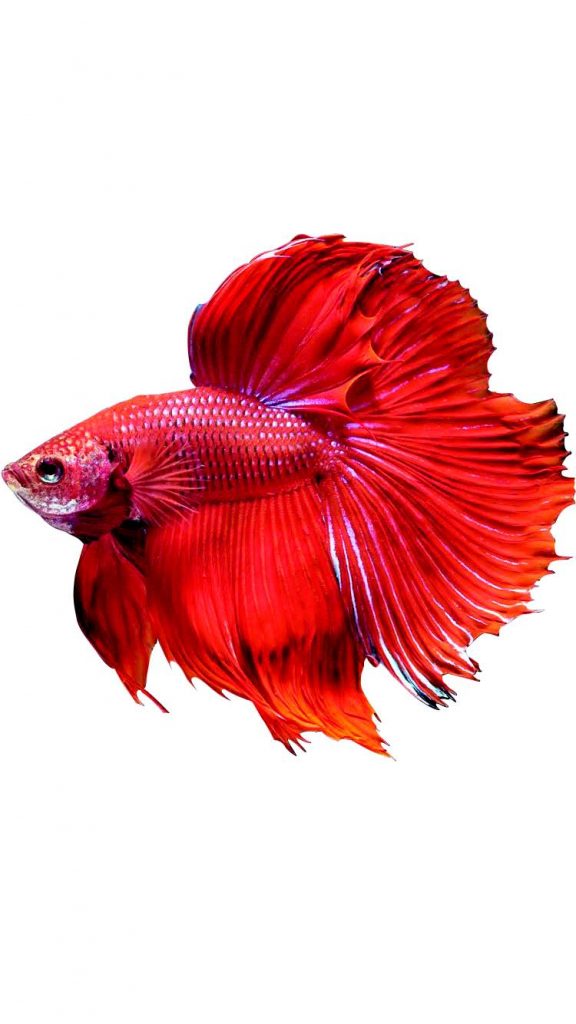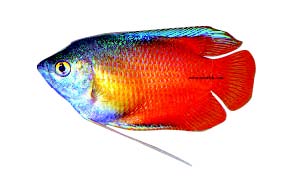Red is the color of excitement, fierceness, and happiness. In Asian countries, it is also a symbol of luck and prosperity. Among fishes, the species that has a dominant red color is the tropical fish.
Dominant red-colored (DRC) fishes carry more than 50 percent red color or patterns on their overall body. They are so popular that even commercial fish breeders would go through the process of injecting red enhancing color, which is why fish food with red color enhancers are widely sold commercially.
When I am asked what DRC fish to buy, it is hard to respond easily because there are factors to consider. Most of the time when I visit pet stores, I see customers buy a DRC fish without knowing the basic care they need.
10 dominant red-colored fishes
1. Goldfish

• Popular DRC varieties: Rancho, oranda, ryukin
• Popular non-DRC varieties: Black, sakura, calico, apache
• Housing: Ideal for aquariums and small ponds
• Tankmates: Nonaggressive fish
• Filtration: Needs heavy filtration; overhead, canister, sump
• Temperament: Nonaggressive
• Breeding: Egg layer
• Feeding requirements: Sinking pellets, duckweed, frozen blood worm, flakes
• Ease of care: Beginner
• Robust eater
2. Swordtails

• Popular DRC varieties: Red, tuxedo red, albino red
• Popular non-DRC varieties: Black, kohaku, and tricolor
• Housing: Ideal for aquariums and small ponds
• Tankmates: Nonaggressive fish
• Filtration: Overhead, canister, sponge, and box filter
• Temperament: Mildly aggressive
• Breeding: Live bearer
• Feeding requirements: Commercial floating and sinking pellets
• Ease of care: Beginner
• Other popular varieties are regular, double sword, and high fin
• Prone to fungus especially with the albino type
3. Guppies

• Popular DRC varieties: Red, tuxedo red, red wagtail
• Popular non-DRC varieties: Blue moon, mickey mouse, sunset
• Housing: Ideal for aquariums and small ponds
• Tankmates: Nonaggressive fish
• Filtration: Overhead, canister, sponge, and box filter
• Temperament: Nonaggressive
• Breeding: Live bearer
• Feeding requirements: Commercial floating and sinking pellets
• Ease of care: Beginner
• A great community fish
4. Arowana

• Popular DRC varieties: Super red, chili red
• Popular non-DRC varieties: Red tail gold (RTG), cross back gold, high back
gold
• Housing: 50 gallons above with lots of cave hidings
• Tankmates: Same species
• Filtration: Heavy filtration such as trickle, overhead, canister
• Temperament: Aggressive
• Breeding: Egg layer
• Feeding requirements: Commercial floating and sinking pellets
• Ease of care: Advanced, due to size, and feeding requirements
• Arowanas are one of the most expensive aquarium fish. They are known to jump
out of their tanks, and thus proper tank cover is a must.
5. Platies
• Popular DRC varieties: Red, tuxedo red, red wagtail
• Popular non-DRC varieties: Blue moon, mickey mouse, sunset
• Housing: Ideal for aquariums and small ponds
• Tankmates: Nonaggressive fish
• Filtration: Overhead, canister, sponge, and box filter
• Temperament: Nonaggressive
• Breeding: Live bearer
• Feeding requirements: Commercial floating and sinking pellets
• Ease of care: Beginner
• A great community fish
6. African cichlids

• Popular DRC varieties: Zebra or tangerine African
cichlids, red peacock
• Popular non-DRC varieties: Blue pindani, auratus, Jacob
• Housing: 50 gallons above with lots of cave hidings
• Tankmates: Same species
• Filtration: Heavy filtration such as trickle, overhead, canister
• Temperament: Aggressive
• Breeding: Egg layers
• Feeding requirements: Commercial floating and sinking pellets
• Ease of care: Intermediate due to aggressiveness
• Jewel cichlids, although not of the same species, are almost as popular as
African red cichlids
7. Discus

• Popular DRC varieties: Red plakat, crown tail, half moon,
Siamese
• Popular non-DRC varieties: Blue, green, AOC (all other colors)
• Housing: 5 gallons
• Tankmates: Single species
• Filtration: Regular water change
• Temperament: Aggressive to own species
• Breeding: Egg layers
• Feeding requirements: Commercial floating and sinking pellets
• Ease of care: Beginner
8. Koi

• Popular DRC varieties: Kohaku, Sanke, Benigoi, Showa
• Popular non-DRC varieties: Soragoi, Chagoi, Shiro Utsuri
• Housing: Extra large ponds
• Tankmates: Bala shark, tin foil, angelfish
• Filtration: Vortex, Bakki shower, large sump
• Temperament: Nonaggressive
• Breeding: Egg layers
• Feeding requirements: Floating koi feeds, vegetables, occasional flake food
• Ease of care: Intermediate due to its size
• They are best viewed from the top
9. Betta

• Popular DRC varieties: Red Melon, red tortoise, red pigeon
blood
• Popular non-DRC varieties: Blue tortoise
• Housing: High tanks, 75 gallons above
• Tankmates: Slow nonaggressive
• Filtration: Canister, sponge
• Temperament: Semi-aggressive
• Breeding: Egg layers
• Feeding requirements: High protein commercial feeds, blood worms, beef heart
• Ease of care: Difficult
• They are considered the king of tropical fish
10. Gourami

• Popular DRC varieties: Honey red, flame dwarf
• Popular non-DRC varieties: Neon, pearl, blue
• Housing: 20 gallons and up
• Tankmates: Nonaggressive fishes
• Filtration: Overhead, canister, sponge, under gravel
• Temperament: Semi-aggressive toward own species
• Breeding: Egg layers
• Feeding requirements: Commercial sinking pellets, blood worms
• Ease of care: Beginner
Get them RED-y
Genetics, lighting, food intake, and fish health are the major factors that intensify the fishes’ redness. Unhealthy fish will show discoloration.
Aside from color, a fish’s beauty will be more appreciated with proper tank or pond water care, color backgrounds, and ornamental accessories. A variety of red fishes will be a sight to behold.
A school of red albino swordtails, albino red guppies, and platies is worth making a set up. For a hobbyist with a higher budget, a tank community of super red Arowana or red melon discus is a classic.
Next time you visit a pet store, spend some time observing and counting how many red fish varieties are available and you will be amazed.
This appeared in Animal Scene magazine’s June 2019 issue.
Related stories:
– A betta place: Why you shouldn’t keep your bettas in bowls
– A simply magnificent fish and gourami
– Appreciating our Philippine Koi






